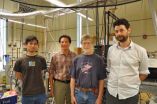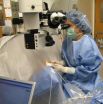(Press-News.org) Researchers from Rigshospitalet – Copenhagen University Hospital – and the University of Copenhagen have discovered why malaria parasites are able to hide from the immune defences of expectant mothers, allowing the parasite to attack the placenta. The discovery is an important part of the efforts researchers are making to understand this frequently fatal disease and to develop a vaccine.
Staff member at CMP. Photo: Lars Hviid"We have found one likely explanation for the length of time it takes for the expectant mother's immune defences to discover the infection in the placenta," says Lea Barfod, MSc, who is working with Professor Lars Hviid at the Centre for Medical Parasitology, University of Copenhagen.
"The parasites are able to assume a camouflage that prevents their recognition by the immune system antibodies which would otherwise combat them. So although the immune system has all the weapons it needs to fight the infection of the placenta, these weapons are ineffectual simply because the enemy is hard to spot. Ironically the camouflage also consists of antibodies, but of a type that does not help to fight infection."
The malaria parasite at war with the immune system
One human being in twelve is infected with malaria. That means 500 million people are carrying the tiny parasite, and it kills a million of them a year. The disease costs so many lives because the parasite constantly outmanoeuvres the human immune system. It starts by hiding in the red blood cells. The immune system does not bother with these as the spleen usually filters defective blood cells.
To avoid this filter, the parasite ejects a protein hook which attaches to the inner wall of the blood vessel, and even if the immune system antibodies destroy one such hook, the parasite has more than sixty in its arsenal. One of them has evolved specially to attach to the placenta. While the war is being waged the parasite propagates and infects more and more red blood cells, which are normally used for transporting nutrients and oxygen around the body.
Fighting from house to house
"In an advanced version of hide-and-seek the parasites keep looking for new ways of preventing the antibodies from recognising them. It is a kind of urban guerrilla war in which the fighting is conducted from house to house," says Lars Hviid.
"One example is the ability of the parasites to hide in the placenta. The first time an African woman conceives her placenta provides a new opportunity for the parasite to hide: a new house, so to speak, and in a way that prevents discovery by the immune system. It takes time for the immune defences to react to the new threat, and meanwhile the camouflaged parasite harms the woman and her unborn child."
The researchers are now going to study whether the malaria parasite also uses its camouflage at other stages of an infection.
"Perhaps it is not only the parasites in the placenta that are capable of hiding like this," Lars Hviid says.
"It takes the body a surprisingly long time to develop protection from Malaria, and perhaps the trick we have just discovered is part of the explanation. It is important for us to find out if this is the case in order to help us to understand malaria in general, but also to help us in our efforts to develop a vaccination. We have plenty of work to be going on with," Lars Hviid concludes.
###
Lea Barfod and Lars Hviid's discovery has just been published in the Proceedings of the National Academy of Sciences of the United States of America.
Malaria parasites use camouflage to trick immune defences of pregnant women
2011-07-12
ELSE PRESS RELEASES FROM THIS DATE:
Pitt team finds way to classify post-cardiac arrest patients to better predict outcomes
2011-07-12
PITTSBURGH, July 11 – A new method for scoring the severity of illness for patients after cardiac arrest may help to predict their outcomes, according to researchers at the University of Pittsburgh School of Medicine. Most importantly, their findings, published in the early online version of Resuscitation, also show that none of the severity categories rules out the potential for a patient's recovery.
"Traditionally, we have used historical or event-related information, such as initial cardiac rhythm or whether someone witnessed the collapse, to categorize these patients ...
Owl study expands understanding of human stereovision
2011-07-12
Rockville, Md. — Using owls as a model, a new research study reveals the advantage of stereopsis, commonly referred to as stereovision, is its ability to discriminate between objects and background; not in perceiving absolute depth. The findings were published in a recent Journal of Vision article, Owls see in stereo much like humans do.
The purpose of the study, which was conducted at RWTH Aachen (Germany) and Radboud University (Nijmegen, Netherlands), was to uncover how depth perception came into existence during the course of evolution.
"The reason why studying ...
Health-care practitioners' stories can aid medical device designers
2011-07-12
Health care laws to protect patients' privacy make it nearly impossible for medical device designers to develop and test the safety and usability of medical products by observing use in an actual practitioner-patient setting. As a result, usability errors and hazards may be overlooked, with the potential for devastating consequences. In the recent issue of Ergonomics in Design, human factors/ergonomics researchers found that storytelling as a qualitative research method was a more effective—and stimulating—way for health care practitioners to provide valuable insights during ...
Chicks dig certain types of music
2011-07-12
What accounts for the sounds we like to hear? Is it something about the properties of our auditory systems or brains? Or are such tastes learned? Two-month-old human infants show a preference for consonant, or gentler harmonies over more dissonant or harsher ones. But it's still impossible to know whether that preference is inborn, since the babies may have been exposed to certain sounds, even in utero.
Birds show similar behaviors: they can distinguish between different kinds of sounds and certain species are attracted to certain sounds. But because no one had experimented ...
Even before language, babies learn the world through sounds
2011-07-12
It's not just the words, but the sounds of words that have meaning for us. This is true for children and adults, who can associate the strictly auditory parts of language— vowels produced in the front or the back of the mouth, high or low pitch—with blunt or pointy things, large or small things, fast-moving or long-staying things.
Do the same principles apply for young infants, and not just to things, but also to abstractions? A new study by Marcela Peña, Jacques Mehler, and Marina Nespor, working together at the International School for Advanced Studies, in Trieste, ...
UC Riverside physicists discover new way to produce antimatter-containing atom
2011-07-12
RIVERSIDE, Calif. – Physicists at the University of California, Riverside report that they have discovered a new way to create positronium, an exotic and short-lived atom that could help answer what happened to antimatter in the universe, why nature favored matter over antimatter at the universe's creation.
Positronium is made up of an electron and its antimatter twin, the positron. It has applications in developing more accurate Positron Emission Tomography or PET scans and in fundamental physics research.
Recently, antimatter made headlines when scientists at CERN, ...
More oxygen in eyes of African-Americans may help explain glaucoma risk
2011-07-12
AUDIO:
Optic nerve damage from glaucoma seems to be at least partly related to damage from byproducts of oxygen in the eye. now, measuring oxygen levels during eye surgery, researchers at...
Click here for more information.
Measuring oxygen during eye surgery, investigators at Washington University School of Medicine in St. Louis have discovered a reason that may explain why African-Americans have a higher risk of glaucoma than Caucasians.
They found that oxygen levels ...
Too much sitting may be bad for your health
2011-07-12
San Diego, CA, July 12, 2011 – Lack of physical exercise is often implicated in many disease processes. However, sedentary behavior, or too much sitting, as distinct from too little exercise, potentially could be a new risk factor for disease. The August issue of the American Journal of Preventive Medicine features a collection of articles that addresses many aspects of the problem of sedentary behavior, including the relevant behavioral science that will be needed to evaluate whether initiatives to reduce sitting time can be effective and beneficial.
"Epidemiologic and ...
The metabolic effects of antipsychotic drugs
2011-07-12
07/07/11, Clearwater Beach, FL. Research to be presented at the upcoming annual meeting of the Society for the Study of Ingestive Behavior (SSIB), the foremost society for research into all aspects of eating and drinking behavior, may explain why some antipsychotic drugs can promote overeating, weight gain, and insulin resistance.
Olanzapine, an atypical antipsychotic drug approved by the FDA for the treatment of schizophrenia and bipolar disorder, has been associated with body weight gain and impaired glucose homeostasis in humans and in experimental animals. As part ...
Feeding hormone ghrelin modulates ability of rewarding food to evoke dopamine release
2011-07-12
07/07/11, Clearwater Beach, FL. New research findings to be presented at the upcoming annual meeting of the Society for the Study of Ingestive Behavior (SSIB), the foremost society for research into all aspects of eating and drinking behavior, finds that ghrelin, a natural gut hormone that stimulates feeding, also modulates the ability of tasty food and food-related cues to alter dopamine levels within the striatum, a critical component of the brain's reward system.
Scientists measured dopamine in 'real-time' while rats ate sugar, a highly rewarding food. Administering ...

